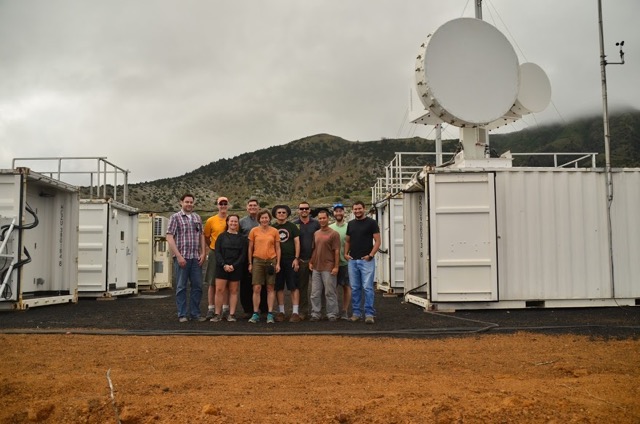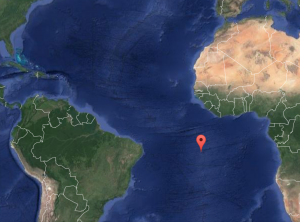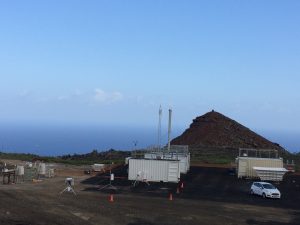Posted December 15, 2016
By DANIEL LLOVERAS
When you think about climate change, the images should be clear in your mind: power plants feeding the atmosphere with carbon dioxide, sea level rise engulfing coastal areas, glaciers collapsing under the weight of their melting ice.
However, there is one aspect of climate change that often gets overlooked: smoke.
Click to view a video slideshow narrated by writer Daniel Lloveras about Ascension Island smoke research.
That’s what Dr. Paquita Zuidema, professor of atmospheric sciences at the University of Miami Rosenstiel School of Marine and Atmospheric Science (RSMAS), and her international research team are investigating in a first-of-its-kind study.
The study, known as Layered Atlantic Smoke Interactions with Clouds (LASIC), is the first ever to thoroughly examine the effect of smoke from African wildfires on low clouds above the Atlantic Ocean. The radiative behavior of low-level Atlantic clouds is one of the largest uncertainties in forecast models, so the study could be vital to improving climate and weather predictions.
“While smoke acts as a blanket to warm the atmosphere, low-level clouds reflect sunlight, resulting in climate cooling,” Zuidema said. “Yet, it is unknown whether interactions between smoke and clouds result in net cooling or warming of the atmosphere.”

Dr. Paquita Zuidema (front row, second from left) and her team of scientists at the research site on Ascension Island (Photo courtesy of Paquita Zuidema).
Southern Africa is the world’s largest emitter of smoke particles, known as biomass-burning aerosols. These particles are transported far offshore and can have widespread effects on both regional and global climate.
“The burning of grasslands and other biomass on the African continent unleashes an unprecedented amount of smoke into the atmosphere,” Zuidema said. “The key is to understand whether the smoke strengthens or weakens the low-level cloud deck.”
LASIC is being conducted on Ascension Island, a remote volcanic island in the middle of the south Atlantic Ocean.

Ascension Island, the location for the LASIC study, is in the middle of the south Atlantic Ocean (Photo courtesy of Google Maps).
The island is in the ideal location to directly observe smoke that has been in the atmosphere for a long time, about which is not well understood.
“Ascension is located directly underneath one of the biggest smoke plumes in the world,” Zuidema said. “The remote location allows us to sample the smoke after it is well-aged, something we are unable to do at continental research sites.”
The international research team is made up of scientists from five different countries: The United States, the United Kingdom, France, Namibia and South Africa.
According to Dr. Jim Haywood, professor of atmospheric science at the University of Exeter in England and co-investigator for LASIC, coordination among the international team has made for a logistically smooth study.
“Since Ascension is a base for both British and American military, we had the connections to establish a comprehensive research site,” Haywood said. “The island is sparsely populated and is primarily used for scientific and military purposes.”
Zuidema received a $365,050 grant from the U.S. Department of Energy to fund LASIC. The money has been used to pay for the surface instruments and aircraft missions, which have provided valuable data.
“The combination of in situ (on site) and remote sensing instruments has provided us with a wide variety of data,” Zuidema said. “That will help reduce much of the uncertainty associated with making these types of measurements.”
According to Thomas Gard, an undergraduate research assistant at RSMAS and one of Zuidema’s students, LASIC has the potential to be a pioneering study in the field of climate science.
“I think that this is one of the most fascinating studies in climate science today,” Gard said. “The remote location provides such a unique opportunity to collect data that can provide large-scale conclusions on the behavior of Earth’s climate.”
Haywood said that the data collected from Ascension Island has been robust, meaning that it is of high quality and is very intensive. The scientists have been able to analyze low cloud behavior with limited uncertainty and error.
“The measurements are able to highlight the strengths and weaknesses of numerical weather prediction models and climate models that forecast smoke intrusions over the island,” Haywood said. “This will ultimately lead to improved regional and global weather and climate predictions.”
The study began in June 2016 and will continue through October 2017, giving Zuidema and her team plenty of time to collect data in both smoky and clear conditions.
“The long deployment time has allowed us to characterize the marine low clouds both with and without the presence of smoke,” Zuidema said.
The entire world relies on forecast models in order to plan for a changing climate, so the importance of studies to improve those models cannot be overstated.
“This study will provide valuable information on Earth’s energy balance,” Zuidema said. “The information may improve the accuracy and legitimacy of numerical climate projections.”

